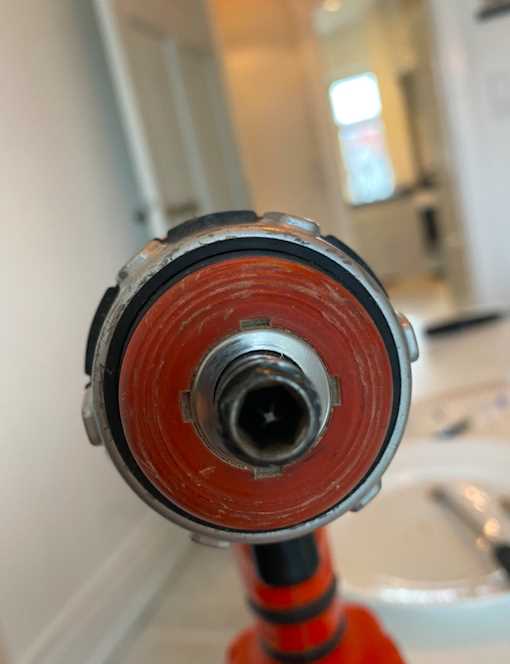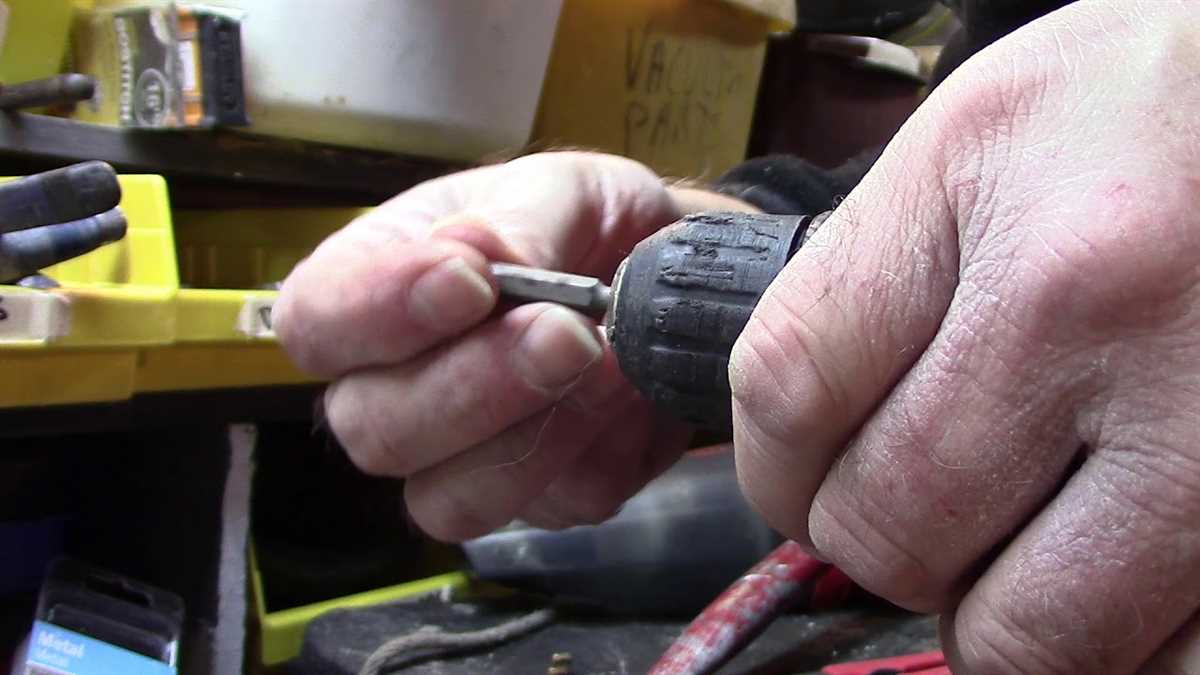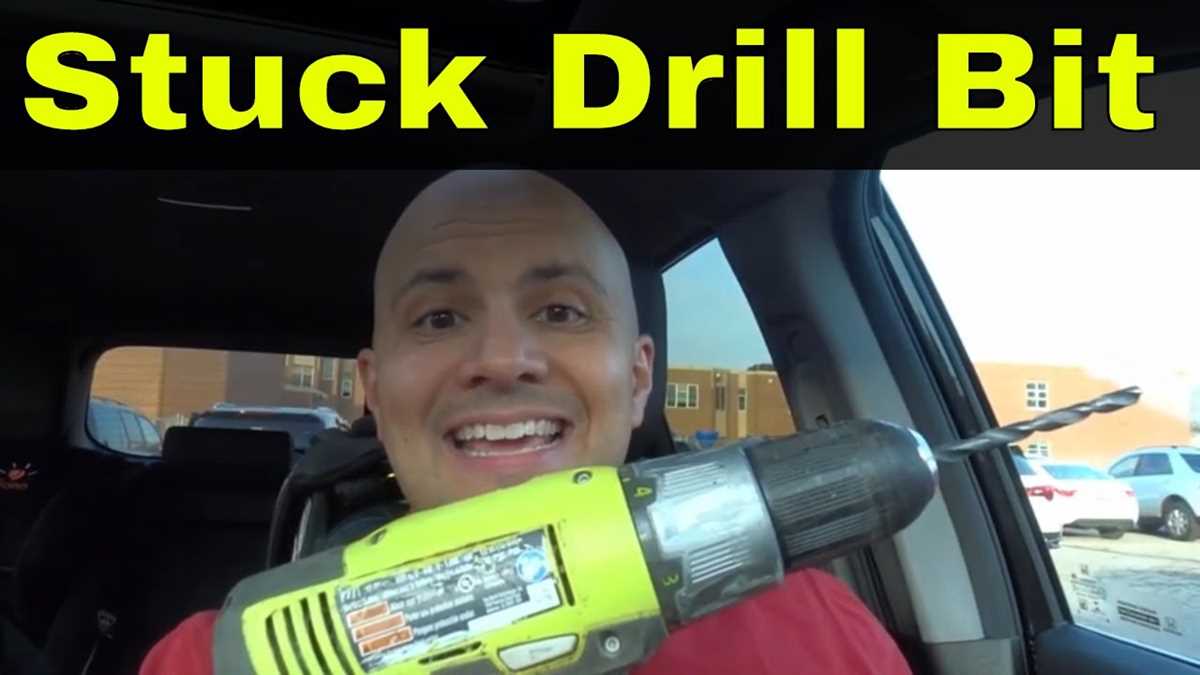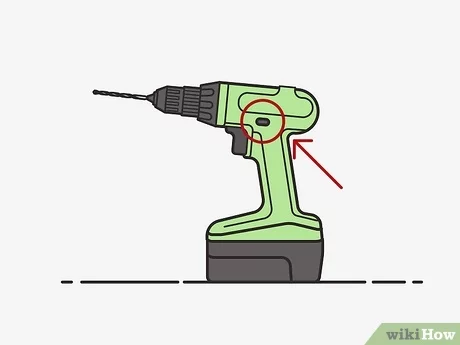Simple Steps to Free a Stuck Drill Bit

Having a stuck drill bit can be a frustrating experience, especially when you’re in the middle of a project and need to get it unstuck quickly. However, with a little patience and the right techniques, you can free a stuck drill bit without damaging your tools or work surface.
One common reason why a drill bit may become stuck is due to excessive heat and friction. When drilling into certain materials, such as metal or hardwood, the drill bit can generate heat, causing it to expand and become wedged in the hole. To free a stuck drill bit in this situation, it’s important to let the bit cool down before attempting to remove it. This can be done by turning off the drill and allowing it to sit for a few minutes.
If the drill bit remains stuck even after it has cooled down, you can try applying a lubricant to the area. This can help reduce friction and make it easier to remove the bit. Some common lubricants that can be used include WD-40, grease, or even dish soap. Apply a small amount of the lubricant to the stuck area and let it sit for a few minutes. Then, try turning the drill bit in the opposite direction to remove it.
If the above steps don’t work, you may need to use additional tools to free the stuck drill bit. One method is to use pliers or a wrench to grip the drill bit and gently twist it out. Be sure to use a tool that won’t damage the bit or the drill itself. Another method is to use a hammer and a drift punch to tap the drill bit out from the opposite side. This should be done carefully and in small increments to avoid damaging the work surface.
In conclusion, freeing a stuck drill bit can be accomplished with the right techniques and a little patience. By allowing the bit to cool down, applying lubricant, and using additional tools if necessary, you can successfully remove the stuck drill bit without causing any damage. Remember to always wear protective gear when working with power tools and follow the manufacturer’s instructions for proper tool use and maintenance.
Identify the Problem
Before trying to free a stuck drill bit, it’s important to first identify the problem. There could be several reasons why a drill bit becomes stuck, and understanding the cause will help determine the appropriate solution.
Reasons for a stuck drill bit:

- Obstructions: The drill bit may have encountered an obstruction such as a knot in wood or a hard material like metal. This can cause the bit to get stuck or break.
- Excessive Friction: If the drill bit becomes too hot due to excessive friction, it can expand and get stuck in the material being drilled.
- Improper Technique: Using too much force or drilling at an incorrect angle can cause the drill bit to become stuck.
Signs of a stuck drill bit:
- Lack of Progress: If the drill isn’t making any progress or is very slow, it could be an indication that the bit is stuck.
- Resistance: Increased resistance or difficulty in turning the drill can be a sign of a stuck bit.
- Weird Noises: Unusual noises such as grinding or scraping sounds could indicate that the drill bit is stuck.
By identifying the problem correctly, you can then proceed to the appropriate steps to free the stuck drill bit. This will help avoid further damage to the bit, the tool, or the material being drilled.
Gather Necessary Tools

Before attempting to free a stuck drill bit, it is important to gather the necessary tools. Having these tools readily available will make the process smoother and more efficient.
Here is a list of the tools you will need:
- A pair of pliers or locking pliers
- A hammer
- A lubricant, such as WD-40 or penetrating oil
- A drill bit extractor or a screw extractor
- A drill
- A drill press (optional)
Additional tools that may be helpful:
- A heat gun or propane torch (if the drill bit is stuck due to excessive heat or rust)
- A vice or clamp (to secure the workpiece)
- A punch or center punch (to create a starting point for the drill bit extractor)
Once you have gathered all the necessary tools, you will be ready to proceed with freeing the stuck drill bit.
Lubricate the Drill Bit
When a drill bit gets stuck, one possible solution is to lubricate it. Lubricating the bit can reduce friction and make it easier to free. Here are some steps to follow:
Step 1: Prepare the lubricant
- Choose a suitable lubricant, such as WD-40 or a multipurpose oil.
- If the drill bit is stuck in metal, use a lubricant specifically designed for metal surfaces.
Step 2: Apply the lubricant
- Spray the lubricant directly onto the stuck drill bit.
- Make sure to cover the entire length of the bit.
Step 3: Let it sit
- Allow the lubricant to penetrate and work on the stuck drill bit.
- Wait for a few minutes to let the lubricant do its job.
Step 4: Attempt to remove the drill bit
- After the lubricant has had time to work, try to free the drill bit.
- Use a pair of pliers or a wrench to gently twist and turn the bit in both directions.
- If the bit starts to move, continue with slow and steady pressure until it is completely freed.
Remember to clean the drill bit and remove any excess lubricant before using it again. This will help prevent future sticking issues.
Apply Pressure and Rotate
In this step, it’s important to apply pressure and rotate the drill bit at the same time. This will help to loosen the stuck bit and allow it to come free.
First, ensure that you have a firm grip on the drill handle. Use your dominant hand to apply pressure downwards, while using your other hand to rotate the drill in a clockwise direction. Apply steady and consistent pressure, but be careful not to use too much force that it damages the drill or the material you are working on.
If the drill bit is still stuck, you can try applying some lubricant or penetrating oil to the area. This can help to reduce friction and make it easier for the bit to come free. Allow the lubricant to sit for a few minutes before attempting to rotate the bit again.
If you are still unable to free the stuck drill bit, it may be necessary to use additional tools or seek professional assistance. Using excessive force or incorrect techniques can lead to damage or injury, so it’s important to proceed with caution and prioritize safety.
Use a Hammer and Chisel

If your drill bit is stuck, a hammer and chisel can be a useful tool to free it. Follow these steps:
- Step 1: Put on safety goggles and gloves to protect yourself from flying debris.
- Step 2: Take a hammer and gently tap the chisel into the hole where the drill bit is stuck.
- Step 3: Hold the chisel at a slight angle and apply steady pressure to the side of the hole as you tap it with the hammer. This will help to loosen the grip of the stuck bit.
- Step 4: Continue to tap the chisel and apply pressure until the drill bit starts to loosen. Be patient and take your time to avoid damaging the drill or bit.
- Step 5: Once the drill bit is freed, inspect it for any damage. If it appears to be in good condition, you can continue using it. Otherwise, replace the bit with a new one.
Using a hammer and chisel can be an effective method to free a stuck drill bit. However, exercise caution and be mindful of your safety while using these tools.
Apply Heat
Applying heat to the stuck drill bit can help loosen it and make it easier to remove. Heat can expand the metal and break any rust or corrosion that may be causing the bit to stick.
Here are the steps to apply heat to a stuck drill bit:
- Prepare the drilling area: Clear the area around the stuck drill bit to ensure it is safe to work with heat.
- Heat source: Use a heat source such as a propane torch or a heat gun. Make sure to follow the manufacturer’s instructions and safety precautions when using these tools.
- Apply heat: Direct the heat source towards the stuck drill bit. Move the heat source around the drill bit to evenly distribute the heat.
- Give it time: Allow the heat to penetrate the metal and break any rust or corrosion for a few minutes.
- Try removing the drill bit: After applying heat, try to remove the stuck drill bit using pliers or a wrench. If it still doesn’t come out, proceed to the next step.
If applying heat doesn’t free the stuck drill bit, there may be other factors causing it to stick, such as a damaged chuck or worn-out gears. In such cases, it may be necessary to seek professional help or replace the drill altogether.
Use a Screw Extractor
If the drill bit is stuck because it has broken off inside a screw or bolt, you can use a screw extractor to remove the broken bit.
Here’s how to use a screw extractor:
- Drill a small hole into the center of the broken drill bit using a power drill and a small drill bit.
- Insert the screw extractor into the drilled hole.
- Turn the screw extractor counterclockwise using a wrench or pliers. The extractor will grip onto the broken drill bit.
- Continue turning the screw extractor counterclockwise until the broken drill bit is completely removed from the screw or bolt.
Note: It is important to use the correct size screw extractor for the size of the broken drill bit. Using an extractor that is too small may not provide enough grip, while using one that is too large may damage the surrounding material.
Caution: When using a screw extractor, be sure to apply steady pressure and avoid applying excessive force, as this can cause the extractor to break off inside the screw or bolt.
Using a screw extractor is an effective way to remove broken drill bits and get your project back on track. Just be sure to follow the instructions carefully and use caution to avoid causing further damage.
Seek Professional Help if Needed

If you have tried all the steps listed above and the drill bit is still stuck, it may be time to seek professional help. Professional technicians have the experience and tools necessary to safely remove a stuck drill bit without causing further damage to the drill or the material you are working on.
There are several signs that indicate you should seek professional help:
- If you have already tried all the steps mentioned in this guide and the drill bit is still not free.
- If you are unsure about how to properly work with power tools and do not want to risk injury.
- If you are working on a valuable or delicate material and do not want to risk damaging it further.
- If you do not have the necessary tools or equipment to safely remove the stuck drill bit.
When seeking professional help, it is important to choose a reputable technician or repair service. Look for technicians who specialize in power tool repair or have experience working with stuck drill bits. You can ask for recommendations from friends, colleagues, or even online forums dedicated to DIY projects.
Before taking your drill to a professional, make sure to remove any batteries or power sources to prevent accidental starts and ensure the safety of the technician. Additionally, be prepared to explain the steps you have already taken to try and free the stuck drill bit, as this information can help the technician diagnose the issue more efficiently.
While seeking professional help may incur additional costs, it is often the safest and most effective solution when dealing with a stubbornly stuck drill bit. Remember, attempting to force or remove the drill bit without proper knowledge or tools can result in damage to your drill and potential injuries.
FAQ:
What should I do if my drill bit gets stuck?
If your drill bit gets stuck, the first step is to stop drilling and turn off the drill. Then, you should assess the situation to determine the cause of the problem. In some cases, you may be able to simply pull the bit out by hand. If the bit is stuck due to excessive torque or pressure, you may need to use a wrench or pliers to loosen it. Another option is to use a lubricant or penetrating oil to help loosen the bit. If none of these methods work, you may need to consult a professional for assistance.
What are some common reasons for a stuck drill bit?
There can be several reasons why a drill bit gets stuck. One common reason is that the bit is too dull or damaged, causing it to become wedged in the material you are drilling. Another possibility is that excessive torque or pressure has caused the bit to become stuck. Additionally, if the material you are drilling is particularly hard or dense, it can also contribute to the bit getting stuck. Finally, using the wrong type or size of drill bit for the job can also lead to a stuck bit.
Can I use force to free a stuck drill bit?
While it may be tempting to use force to free a stuck drill bit, it is generally not recommended. Excessive force can cause damage to both the drill and the bit, and can also be dangerous for the person using the drill. Instead, it is best to try more gentle methods such as using a wrench or lubricant to loosen the bit. If these methods do not work, it is best to seek professional help to avoid causing further damage.
What should I do if the drill bit remains stuck after trying these steps?
If the drill bit remains stuck after trying the steps mentioned in the article, it may be necessary to seek professional help. A professional can assess the situation and provide the necessary expertise and tools to safely remove the stuck bit. Attempting to force or pry the bit out yourself can cause further damage to both the drill and the material you are working with. It is always better to err on the side of caution and seek professional assistance when dealing with a stuck drill bit.
Video:













